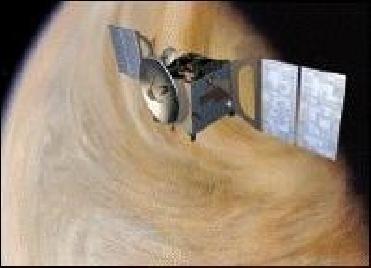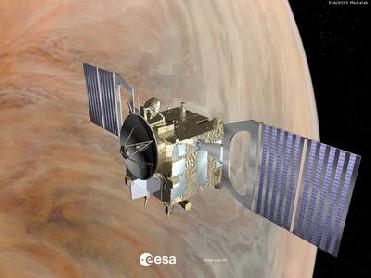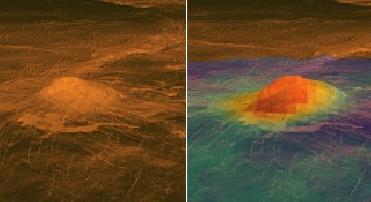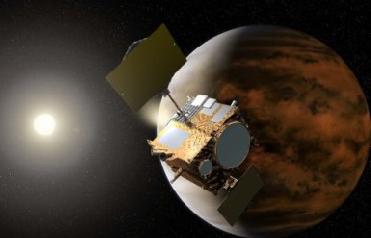
An artist's impression of Venus Express orbiting Venus. -- Image credit: ESA
PARIS (BNS): A new map of Venus�s southern hemisphere, charted out by European Space Agency�s Venus Express, has hinted that the planet might have a plate tectonics system, indicating the presence of volcanoes, and an ocean of water in the past.
The Venus Express, orbiting Venus for the last three years, has mapped for the first time, the planet�s southern hemisphere at infrared wavelengths, according to the ESA.
The map comprises over a thousand individual images, taken between May 2006 and December 2007. Although radar systems have been used in the past to provide high-resolution maps of Venus� surface, the map produced by Venus Express takes a closer look at the chemical composition of the planet�s rocks.
The new data strengthen astrologers� belief that the highland plateaus of Venus are ancient continents, once surrounded by ocean and produced by past volcanic activity.
�This is not proof, but it is consistent. All we can really say at the moment is that the plateau rocks look different from elsewhere,� said Nils M�ller at the Joint Planetary Interior Physics Research Group of the University M�nster and DLR Berlin, who headed the mapping work.
The rocks look different because of the amount of infrared light they radiate into space, similar to the way a brick wall heats up during the day and gives off its heat at night. Besides, different surfaces radiate different amounts of heat at infrared wavelengths owing to a material characteristic known as emissivity.
The Visible and Infrared Thermal Imaging Spectrometer (VIRTIS) instrument captured this infrared radiation during Venus Express�s night-time orbits around the planet�s southern hemisphere, the space agency said.
The new map shows that the rocks on the Phoebe and Alpha Regio plateaus are lighter in colour and look old compared to those found in majority parts of the planet. On Earth, such light-coloured rocks are usually granite and form continents.
Granite is formed when very old rocks, made of basalt, are driven down into the planet by shifting continents, a process known as plate tectonics. The water combines with the basalt to form granite and the mixture is reborn through volcanic eruptions.
�If there is granite on Venus, there must have been an ocean and plate tectonics in the past,� said M�ller.
According to him, the only way to know for sure whether the highland plateaus are continents is to send a lander to the region. Over time, Venus� water has been lost to space, but there might still be volcanic activity. The infrared observations are very sensitive to temperature. But in all images they saw variations of only 3�20�C, instead of the kind of temperature difference they would expect from active lava flows.
Although Venus Express did not see any evidence of ongoing volcanic activity this time around, M�ller did not rule it out. �Venus is a big planet, being heated by radioactive elements in its interior. It should have as much volcanic activity as Earth,� he said. Indeed, some areas do appear to be composed of darker rock, which hints at relatively recent volcanic flows.
The new map gives astronomers another tool in their quest to understand why Venus is so similar in size to Earth and yet has evolved so differently.
 Previous Article
Previous Article Next Article
Next Article













The Indian Air Force, in its flight trials evaluation report submitted before the Defence Ministry l..
view articleAn insight into the Medium Multi-Role Combat Aircraft competition...
view articleSky enthusiasts can now spot the International Space Station (ISS) commanded by Indian-American astr..
view article